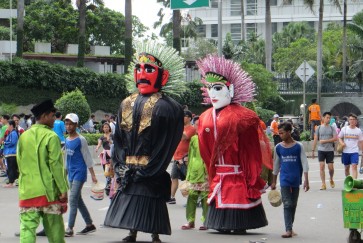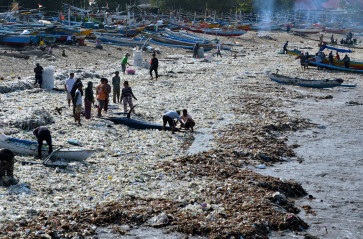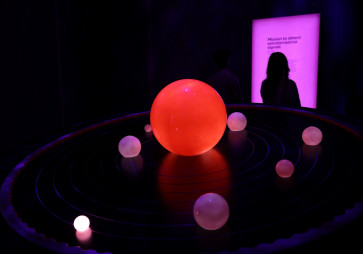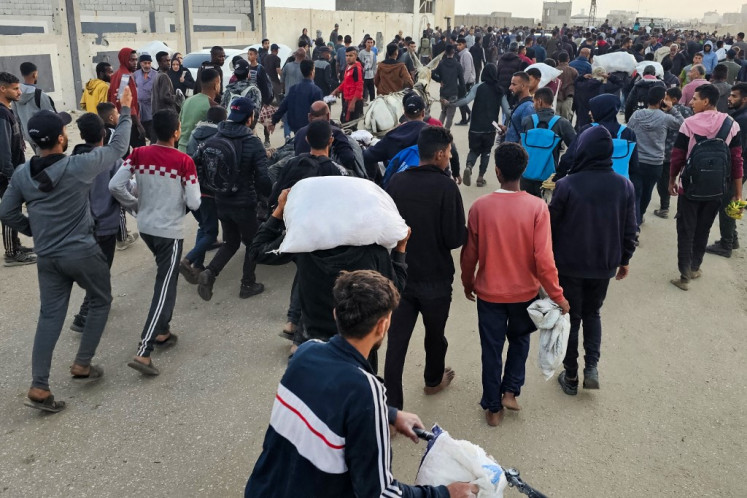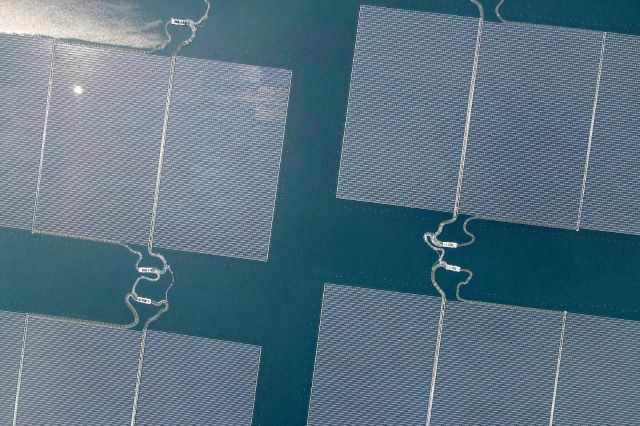Artists commemorate the centennial of Sultan Hamengkubuwono IX
A painting by Woro Anindyah, Ksatria Tanah Java (The Knight from Java) 200x160cm, acrylic on canvas, depicts a cultural event at the palace
Change text size
Gift Premium Articles
to Anyone

A
span class="caption" style="width: 398px;">A painting by Woro Anindyah, Ksatria Tanah Java (The Knight from Java) 200x160cm, acrylic on canvas, depicts a cultural event at the palace. JP/Munarsih SahanaWhile the late Sultan Hamengkubuwono IX of Yogyakarta is remembered as a great statesman thanks to his significant role in the early development of the nation, visual artists also acknowledge his contribution to creating an atmosphere conducive to artistic expression in the region.
A group of 124 artists educated here or were born and developed their artistic career in Yogyakarta are dedicating 131 pieces for an exhibition to commemorate the centennial of the late sultan, themed Nagari Ngayogyakarta Hadiningrat at the Jogja National Museum (JNM) on April 13 to 17.
On the first floor of the historic three-storey building formerly used as the Indonesian Arts College (ASRI), visitors are treated to a variety of works depicting how the artists perceived the late sultan and the Javanese life surrounding him.
Painter Yuli Kodo, who has labored in his artistic talents to visualize Javanese philosophical values, offers nine different-colored images of a man clad in Javanese attire — with surjan (striped long-sleeved shirt) and wrapped in batik kain (wrap-around skirts) — titled Sembilan Elemen (Nine Elements).
“These nine elements are a reflection of humanity’s different characters and needs. When one has already achieved mastery of all these elements, he or she will always have peace of mind and be willing to dedicate their life to help others, like what Sinuwun [his Majesty] did,” Yuli says of the Javanese beliefs held by the Javanese king.
Raised in a neighborhood close to the sultan’s palace, Yuli admits he greatly respects Sinuwun, who declared his independent sultanate to be part of the Republic of Indonesia as soon as independence was proclaimed in 1945.
Heri Dono, an internationally acclaimed artist who studied in Yogyakarta, incorporates local cultural elements and contemporary techniques in his depiction of the sultan as a super hero like Gatotkaca, a famous character who could fly in the puppetry world, into a combined work: a painting and an installation.
The painting of the sultan flying over a globe is titled D.I.Y (200x160cm, acrylic on canvas), an abbreviation of Daerah Istimewa Yogyakarta (Yogyakarta Special Territory) where the sultan was the governor, and “do it yourself”.
“This is to describe that the sultan was knowledgeable about world affairs at that time, and his commitment to support the independence of the then young Republic of Indonesia”, Dono explains.
The installation Tahta Untuk Rakyat (Throne for the People), the same title of an autobiography about the sultan, consists of a flying hero hanging from a wire that looks more like Superman, with electric devices on the chest, and is connected to a knob on the wall. When one presses the knob, the devices will light up in interesting colors with the wings flapping at the same time.
Woro Anindyah’s thoughts on the late sultan are shown her illustration of a cultural event regularly held at the palace, in Ksatria Tanah Java (The Knight from Java, 200x160cm, acrylic on canvas).
Her big canvas is filled with elaborate images of people from different walks of life attending an event, including images of royal guards on duty, different groups of people in traditional costumes and even the presence of the Queen of the South Sea in dangling-green attire.
Another large painting is on display in the opposite chamber of the gallery, Djoko Pekik’s Kawulo Gonjang Ganjing di Plengkung Gading (The People were Mourning at Gading Gate, oil on canvas, 140x220cm).
It depicts a huge crowd who filled the intersection of the Gading gate to give their last respects to Sultan Hamengkubuwono IX, whose body was carried in a royal horse-drawn cart from the Yogyakarta palace to the Imogiri royal cemetery, around 25 kilometers away.
Karyadi’s Nada Istimewa (Special Rhythm, wood, paint, electric Guitar components, 105x37x6cm) is an interesting sculpture bearing the Yogyakarta palace’s emblem in Javanese characters, which is an abbreviation of Hamengkubuwono.
Karyadi, a graduate of the Indonesian Art Institute Yogyakarta acknowledges his work was an expression of affection to the city where he was born, and the sultan.
Several other works contain strong messages about the special status of Yogyakarta and high respect for the sultan. This includes a large painting by noted artist Nasirun, Sultan Seni Rupa ( Sultan’s Fine Art, oil on canvas, 200x400cm), a silhouette of himself and long letters to celebrate the centenary nicely written in Javanese characters. Similar statements are presented by a number of other artists, such as Andreas Bernadi, Ardian Kresna, Aan Arief.
The second and third floors offer more diverse works, such as wood cuts, installations, sculptures, drawings and video art, as well as multi-media art works by the House of Natural Fiber (HONF) Yogyakarta.
Nindityo Adipurnomo created a painting, Sinuhun Screen (gouache on paper, 96x122cm) together with a video about his imagined meeting with the sultan through an old technique of telepathy.
Traditionally, he says, Javanese people had a particular technique of communicating with loved ones over a long distance, using the surface of water in a barrel usually placed in a back yard.
The artwork display the diversity of art created by those originally from Yogyakarta and those who have developed artistic talents in the city, says curator Dwi Maryanto, a professor at the Indonesian Arts Institute (ISI) Yogyakarta.
“Yogyakarta, which is now becoming more and more multi-cultural, has developed as the best place for artists to work. This does not happen overnight, but instead is the result of the visits by many intellectuals and artists from many parts of the country while it was the capital of the republic in 1946,” he says, before thanking the sultan for allowing that important process to happen.
Negari Ngayogyakarta Hadiningrat Art Festival
Jogja National Museum
Jl. Amri Yahya No.1, Yogyakarta
Open every day during the exhibition
10:00 a.m. – 9:00 p.m.

